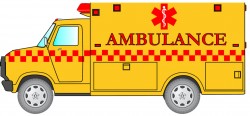 Medicare covers non-emergency ambulance transport, but Medicare often refuses to pay such bills. Apparently, the devil is in the details – and it is up to seniors and their families to understand those details to avoid ambulance billing problems.
Medicare covers non-emergency ambulance transport, but Medicare often refuses to pay such bills. Apparently, the devil is in the details – and it is up to seniors and their families to understand those details to avoid ambulance billing problems.
The Center For Medicare Advocacy offers good advice on how Medicare beneficiaries can avoid ambulance billing problems. Here is a recent memo I received from them:
Non-Emergent Ambulance Transport: Don’t Lose Out on Coverage
Part B of Medicare will generally cover up to 80% of emergent and non-emergent ambulance transports when medically necessary and when transport by any other means could endanger your health. There are also origin/destination requirements; Medicare will typically only cover transports to the nearest appropriate medical facility that can provide the level of care necessary to treat your illness or injury. In a true medical emergency, as long as the transport was to the nearest facility capable of providing the appropriate level and type of care for the patient’s condition then payment should generally be made. However, when the transport is considered non-emergent there are some additional caveats.
Beneficiaries frequently experience denials for non-emergent transports because Medicare regulations require that either the beneficiary be bed-confined and that the beneficiary’s condition is such that other methods of transportation are contraindicated, OR, if his or her medical condition, regardless of bed confinement, is such that transportation by an ambulance is medically required.
Medicare regulations consider “bed confinement” to mean that the beneficiary is
- Unable to get up from bed without assistance;
- Unable to ambulate; and
- Unable to sit in a chair or wheelchair.
Often, when a patient is due for discharge, nurses or other staff help the individual get ready to leave the hospital. This often includes assisting the patient to get dressed and transferring them to a chair or recliner and packing their belongings. This would appear to expedite the discharge process, and be helpful to both the patient and the ambulance crew when they arrive. Common sense dictates that it is easier to stand and pivot a patient onto a stretcher rather than manually lift them from one bed to another. Often, neither nurses nor patients are knowledgeable regarding specific Medicare coverage requirements, and are therefore unaware that these simple actions could cause billing issues going forward.
Ambulance crews are trained to document a beneficiary’s appearance upon their arrival. The “run sheets” they complete will note, for example, whether a beneficiary is found in a chair, or whether they were able to stand and get on the stretcher. Unfortunately, these narratives can be incomplete by failing to note such key facts as whether the beneficiary was actually in reclined position (not actually sitting upright), required total assistance for any transfers, or was unable to walk unassisted. Even more troubling, the absence of specific communication by the staff at the discharging facility could lead to the ambulance crew erroneously documenting that the transport was not medically necessary, all of which could lead to an eventual denial of the claim by Medicare.
Often cases such as these are won on appeal, and coverage for the transport is granted once the details have been explained to an Administrative Law Judge (ALJ). However, the current backlog for Medicare hearings means that getting such a decision granting coverage could potentially take years.
How Can a Medicare Beneficiary Ensure Appropriate Coverage for Non-Emergent Ambulance Transport?
When in a medical facility awaiting transport, a beneficiary should assess whether he or she meets the definition of “bed confined.” Is the beneficiary:
- Unable to transfer without assistance;
- Unable to ambulate (walk), and
- Unable to sit upright due to pain or medical contraindication? (An example of “medically contraindicated” would be an individual immediately following hip fracture repair surgery)
If all of the above are true, it may be wise to question the nurses preparing the beneficiary for discharge, and politely, but firmly, request that he or she remain in bed while awaiting ambulance pickup.
If the beneficiary is not “bed confined” it may be worth discussing with the doctor or nurse whether transport via ambulance is medically necessary – meaning that transport by any other means could jeopardize the patient’s health. An ambulance crew is specially trained to monitor and address changes in a person’s condition during transport, while the driver of, for example, a wheelchair van, is not. If the transport is medically necessary, request that the doctor or nurse communicate this clearly to the ambulance crew so their documentation will reflect this when they submit the bill to Medicare.
If the beneficiary is not bed confined and does not meet the criteria for medically necessary ambulance transport, it might be wise to consider other appropriate alternatives to an ambulance, or understand that he or she could likely be held responsible for the bill.
Finally, if Medicare inappropriately denies coverage of non-emergent ambulance transport, a beneficiary should appeal the decision by following the instructions on the Medicare Summary Notice (MSN). The Center for Medicare Advocacy also offers detailed instructions in our ambulance self-help packet, available at:
http://www.medicareadvocacy.org/self-help-packet-for-ambulance-appeals/.
